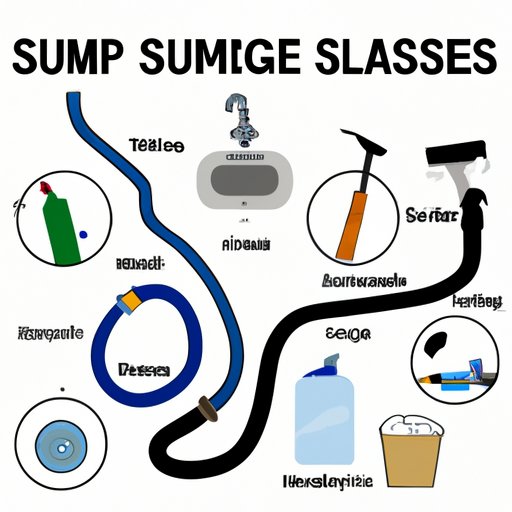Introduction
A clogged kitchen drain is an annoyance that can easily turn into a full-blown plumbing emergency. Not only do clogged drains cause water to back up in your sink, but they can also lead to unpleasant odors and costly repairs if not addressed quickly. Fortunately, there are a number of ways to unclog a kitchen drain without calling a professional plumber.
In this article, we’ll cover eight different methods for unclogging a kitchen drain, from the simplest (using a plunger) to the more involved (calling a professional plumber). We’ll also provide step-by-step instructions for each method so you can get the job done quickly and effectively.
Use a Plunger
Using a plunger is one of the easiest and most effective ways to unclog a kitchen drain. Before getting started, make sure you have the right kind of plunger—a cup plunger or bellows-style plunger is best for sinks and tubs. Also, make sure the plunger is wet before use.
To use a plunger, start by covering the drain with the plunger head and making sure it forms a tight seal. Then, plunge vigorously up and down several times. If the clog is minor, it should break up after a few plunges. If it doesn’t, try again for a few more minutes.
Finally, open the drain and check for any remaining debris. If you still see debris, try plunging again until the drain is completely clear.
Use Boiling Water
Boiling water is another easy way to unclog a kitchen drain. The heat from the boiling water helps to break up grease, soap scum, and other debris that can build up in drains over time. To use boiling water to unclog a drain, simply bring a pot of water to a rolling boil and slowly pour it down the drain.
For best results, wait a few minutes after pouring the boiling water down the drain to let it sit and work its magic. Then, flush the drain with cold water to clear away any remaining debris. You may need to repeat this process a few times to fully clear the clog.
Use Baking Soda and Vinegar
Baking soda and vinegar is a natural combination that can be used to unclog kitchen drains. The baking soda acts as an abrasive to help break up stubborn clogs, while the vinegar helps to dissolve grease and soap scum. To use this method, start by pouring a half cup of baking soda down the drain, followed by a half cup of vinegar.
Once you’ve poured the baking soda and vinegar down the drain, plug the opening with a rag or stopper and let it sit for 30 minutes. After 30 minutes, remove the plug and flush the drain with hot water. Repeat this process if necessary until the clog is cleared.
Use a Drain Snake
A drain snake, also known as a plumbing auger, is a long, flexible tool that can be used to break up stubborn clogs. It works by piercing through the clog and breaking it up so it can be flushed away. To use a drain snake, start by inserting the end of the snake into the drain and pushing it down until it hits the clog.
Once the snake has reached the clog, turn the handle clockwise to begin breaking up the clog. Keep turning the handle until the clog is broken up and then pull the snake out of the drain. Flush the drain with hot water to clear away any remaining debris.
Use a Wet/Dry Vacuum
A wet/dry vacuum is a powerful tool that can be used to unclog kitchen drains. It works by sucking up the clog and removing it from the drain. To use a wet/dry vacuum, start by attaching the hose to the vacuum and sealing the hose tightly around the drain opening.
Then, turn on the vacuum and let it run for a few minutes to suck up the clog. Once the clog is gone, turn off the vacuum and flush the drain with hot water to clear away any remaining debris.
Use Caustic Soda
Caustic soda, also known as lye or sodium hydroxide, is a powerful chemical that can be used to unclog kitchen drains. It works by dissolving grease and soap scum that can accumulate in pipes over time. To use caustic soda, start by mixing one part caustic soda with two parts water in a large bucket.
Once the mixture is ready, carefully pour it down the drain and let it sit for 15 minutes. After 15 minutes, flush the drain with hot water to clear away the caustic soda and any remaining debris. Be sure to wear protective gear when handling caustic soda, as it can be hazardous to skin and eyes.
Call a Professional Plumber
Sometimes, no matter how hard you try, you just can’t get a clog to budge. In these cases, it’s best to call a professional plumber. A professional plumber will be able to assess the situation and determine the best course of action. They may be able to use a specialized tool to unclog the drain or they may recommend replacing the pipes altogether.
When looking for a professional plumber, make sure to do your research. Ask friends and family for recommendations and read online reviews to find a reliable and reputable plumber. Be sure to ask questions about their experience and get a written estimate before hiring them.
Conclusion
Clogged kitchen drains don’t have to be a major headache. With the right tools and know-how, you can easily unclog your kitchen drain in no time. From plungers and boiling water to drain snakes and professional plumbers, there are a variety of methods for unclogging kitchen drains. Hopefully this article has given you the information you need to get the job done quickly and effectively.


